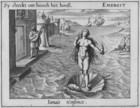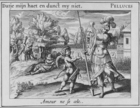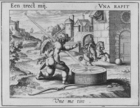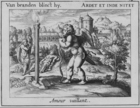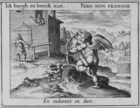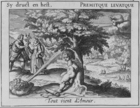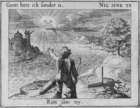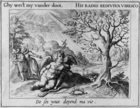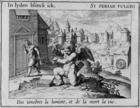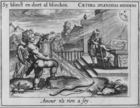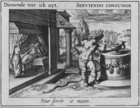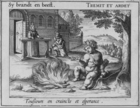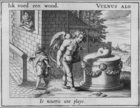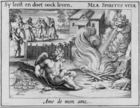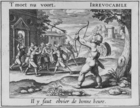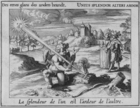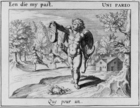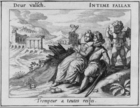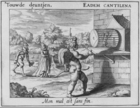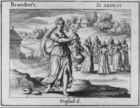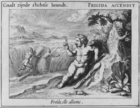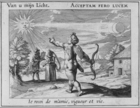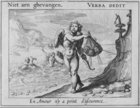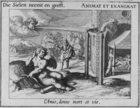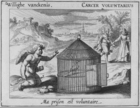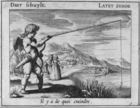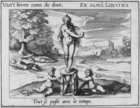VVaerom ghy meer als ick? [9]
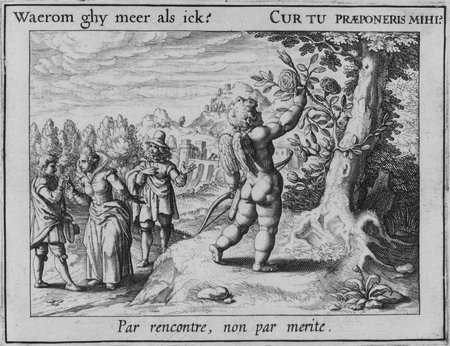
Translations
 |
Waarom wordt gij boven mij gesteld?
|
 |
Why are you preferred to me?
|
 |
Hier een roos en daar een roos: de één behaagt en d’ander plukt men niet,
Niet ieder vindt gelijk naar zijn verdiensten het geluk. |
 |
This is a rose, and that is a rose.
This one they like, but the other they do not pick.
Not everybody fares well in proportion to his merits. |
 |
Bij toeval, niet door verdienste.
|
 |
Van twee gelijke Bloemen wordt alleen de ene uitverkoren,
Van twee gelijkwaardige Minnaars verkrijgt slechts een wat hij verdient. |
Literature
Sources and parallels
-
Henkel and Schöne, Emblemata
 , p. 299
, p. 299
-
A man offering a flower to a woman: So haest als Sol sijn reijs begint nood 't groen de Iuecht bestiert door t'kint [13] (in: anonymous, Cupido’s lusthof (1613))
[Compare
![Compare [compare]](/static/images/compare2.gif) ]
]
-
Love compared to plucking roses in: Armat spina rosas, mella tegunt apes [81] (in: Otto Vaenius, Amorum emblemata (1608))
[Compare
![Compare [compare]](/static/images/compare2.gif) ]
]
-
Woman rejecting lover and rose-bush as symbol of love also in:Tibi mors, mihi vita. [31] (in: Jacob Cats, Sinne- en minnebeelden (1627))
[Compare
![Compare [compare]](/static/images/compare2.gif) ]
]
-
Buschoff 2004, p. 118. Choosing between two lovers: Ingens copia, ingens inopia [107] (in: Otto Vaenius, Amorum emblemata (1608))
[Compare
![Compare [compare]](/static/images/compare2.gif) ]
]
References, across this site, to this page:
- Tibi mors, mihi vita. [31] (in: Jacob Cats, Sinne- en minnebeelden (1627))
- So haest als Sol sijn reijs begint nood 't groen de Iuecht bestiert door t'kint [13] (in: anonymous, Cupido’s lusthof (1613))
- Armat spina rosas, mella tegunt apes [81] (in: Otto Vaenius, Amorum emblemata (1608))
- Ingens copia, ingens inopia [107] (in: Otto Vaenius, Amorum emblemata (1608))
Iconclass
Cupid picking one rose from a rose-bush with two flowers; a woman offering a rose to her lover while gesturing another man to go away- trees
[25G3]

- shrubs: rose-bush
[25G31(ROSE-BUSH)]

- flowers: rose
[25G41(ROSE)]

- (high) hill
[25H113]

- windmill in landscape
[25I41]

- landscape with bridge, viaduct or aqueduct
[25I6]

- arm held backwards (+ keeping off)
[31A2514(+9231)]

- arm held backwards (+ refusing somebody or something)
[31A2514(+9232)]

- hand on the heart
[31A25162]

- adult man (+ two persons)
[31D14(+72)]

- adult woman
[31D15]

- baring the head, lifting one's hat
[33A11]

- presents offered to the beloved
[33C214]

- couple of lovers
[33C23]

- picking flowers
[43B144]

- Choice; 'Elettione' (Ripa) (+ emblematical representation of concept)
[53A11(+4)]

- (personifications and symbolic representations of) Love; 'Amore (secondo Seneca)' (Ripa) (+ emblematical representation of
concept)
[56F2(+4)]

- proverbs, sayings, etc. (with TEXT)
[86(PER RENCONTRE, NON PAR MERITE)]

- proverbs, sayings, etc. (with TEXT)
[86(CUR TU PRAEPONERIS MIHI?)]

- proverbs, sayings, etc. (with TEXT)
[86(WAEROM GHY MEER ALS ICK?)]

- (story of) Cupid, Amor (Eros)
[92D1]

- attributes of Cupid (with NAME)
[92D18(BOW)]

- attributes of Cupid (with NAME)
[92D18(QUIVER)]

Comments
De pictura stelt Cupido voor die een van de twee rozen plukt die op dezelfde tak bloeien. Op de achtergrond kiest de vrouw een minnaar, terwijl ze de andere afwijst. De rozenplukkende Cupido is een variante van een plaat uit Vaenius,
waarbij motto’s en bijschriften betogen dat de liefde ook met verdriet gaat gepaard: geen rozen zonder doornen, of: ’Een minnaer
voor een vreught moet veel verdriet eerst lijden’.1
Als beeld van het meisje dat haar minnaars kiest, komt in de Amorum emblemata het bloemenplukken voor, maar dan als een waarschuwing tegen de gulzige liefde; wie te veel bloemen plukt, vergeet vaak de
eerste2:
Het emblema connoteert de uit de liedboeken bekende erotische betekenis van het ’rozen plukken’ dat, als beeld van de ontmaagding,
ook in de emblematiek voorkomt.3
![[H O M E : Emblem Project Utrecht]](/static/images/rd-small.gif)


